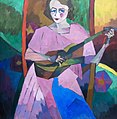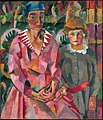Aristarkh Lentulov
Aristarch Vasilyevich Lentulov (Russian Аристарх Васильевич Лентулов; * 4 Januaryjul./ 16 January 1882greg. in Chornaya Pyatina near Nizhny Lomov, Penza Governorate, now: Penza Oblast; † 15 April 1943 in Moscow) was a Russian and Soviet painter, stage designer and educator.
Born into the family of an Orthodox clergyman, Lentulov studied painting at the art academies in Penza (1898-1900 and 1905-1906) and Kiev (1900-1905), then privately with Dmitri Kardovsky in St Petersburg (1906-1907).
First participation in exhibitions in 1907 in St. Petersburg Contemporary Currents and in Kiev The Union, followed in 1909-1910 by exhibitions of the Union of Russian Artists. He was a co-founder of the Moscow artists' group "Jack of Diamonds" (Russian Бубновый валет) in 1910, later as a regular exhibitor until 1927.
From 1910 to 1911 Lentulow studied in Paris in the studio Le Fauconnier and worked in their studio Académie de la Palette. There he met Jean Metzinger, Fernand Léger and Robert Delaunay. After returning home in 1912, he influenced the development of Russian Futurism, including that of Wassily Kandinsky and Kasimir Malevich, with a later transition to Cubo-Futurism - From 1913, Lentulov painted Russian churches and other architectural motifs using a Cubist process. Together with Robert Genin, Alexej Jawlensky, Wassily Kandinsky and Marianne von Werefkin he took part in the Baltic Exhibition in Malmö in 1914.
Even before the October Revolution, Lentulov began designing stage sets for the Moscow Chamber Theatre ("The Merry Wives of Windsor" by William Shakespeare, 1916) and for the Bolshoi Theatre ("Promethée. Le Poème du feu" by Alexander Nikolayevich Scriabin, 1919).
The First Russian Art Exhibition Berlin 1922 showed his paintings Portrait, Landscape, Two Women, Still Life, Landscape.
In 1925 he took part in the Paris "Exposition internationale des Arts Décoratifs et industriels modernes" and was awarded an honorary diploma for the stage design for Rubinstein's opera "The Demon".
In 1928 Lentulov became a member of the Moscow Artists' Association and its chairman. Many members of the association were former members of the "Jacks of Diamonds" group.
Lentulov starts from the search for form and light, which is so typical of the successors of Paul Cézanne's school, still particularly characterized in Russia by their enchanting oriental coloration. While Lentulov painted pictures with a radiant vernacular colourfulness in 1913, he adopted Cézanne's muted colour palette a year later.
Lentulov was also engaged in didactics. Since 1919 he lectured at the Vkhutemas, in 1937 he was appointed professor at the Moscow Surikov Institute.
· 
Woman with guitar 1913
· 
Wife and daughter
· 
Self portrait 1915

St. Basil's Cathedral, Moscow, 1913
Bibliography
- М. Лентулова: Художник А. Лентулов. Воспоминания (Artist A. Lentulov. Memoirs). - Moscow 1969.
Search within the encyclopedia